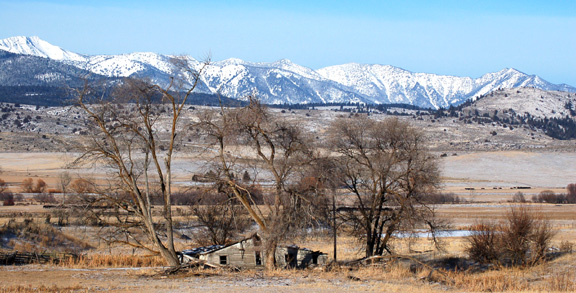Energy, whether from fossil fuels, nuclear fission, or renewables, is a necessity to sustain the burgeoning population of humans and their life sustaining activities, whether it be in Japan, the US & the West, or developing nations in China, India, and elsewhere. Shortages, especially long-term ever increasing shortages in energy, from fossil fuels (See also Wikileaks goes peak-oil wild in Saudi Arabia … or did it?) and nuclear, will lead human populations and their societies towards collapse. Having ignored forty years of warnings to develop renewables and reduce population, humans desperate for energy will take increasing risks to get it with attendant assurances of safety from corporate government. More oil wars and severe economic deterioration are a near certainty if nations refuse to cooperate. This is where we are heading due to our own shortsightedness and inability in the social and political arenas to restrain population growth.
AN INTERVIEW WITH EDWARD ABBEY... from THURSDAY, SEPTEMBER 24, 2009
Obama and Health Care, etc., plus Edward Abbey Tidbit on Growth & Population
"EA) I find nuclear power very unappealing, first of all because it's undemocratic; it centralizes control. It puts our lives and livelihoods in the hands of a very few people, probably one big utility, one big public agency over which the public has very little control. And of course there are the well known dangers of it. (Editor's note: Abbey gave this interview five years before the nuclear disaster at Chernoble) There's no guarantee that these nuclear plants won't break down, melt down and maybe force the evacuation of the entire city of Phoenix someday. And it's a very expensive form of power; I don't know the economic details but it may turn out to cost more that it's worth...simply in dollars. Nuclear power has been a heavily subsidized industry so far, subsidized by us taxpayers in one way or another and that's how it has survived as long as it has. I doubt if nuclear power would last another 10 years if we had a really free market economy. It's expensive and it's dangerous and it's undemocratic, and uranium mining of course also destroys rangeland again, in some cases wilderness. And the problem of what to do with the nuclear waste has still not been solved. Nobody wants these nuclear waste dumps in their own state."More links at bottom of this blog article on population issues.
__
Now on to the tsunami and potential nuclear catastrophe.
Good links for updates:
NUKEFREE.ORG
All Things Nuclear--Insights on Science and Security
Google News
From a friend:
Satellite Photos of Japan, Before and After the Quake and Tsunami
Move the slider from right hand side of photo to the left to compare satellite images--before and after.
__
Markets plummet on fears of a nuclear meltdown
Democracy Now! Special Coverage on Japan's Nuclear Disaster:
March 15, 2011
Japan Facing Biggest Catastrophe Since Dawn of Nuclear Age (DN! 3/14/11)
HARVEY WASSERMAN:
Well, it’s hugely significant, and it’s a very, very dangerous situation. I should note that the first reactor at Fukushima is identical to the Vermont Yankee plant, and which is now up for relicensing and which the people of Vermont are trying to shut. And we should also note that this kind of accident, this kind of disaster, could have occurred at four reactors in California, had the 9.0-Richter-scale earthquake hit close to Diablo Canyon at San Luis Obispo or San Onofre between L.A. and San Diego. We could very well now be watching Los Angeles or San Diego being evacuated, had this kind of thing happened in California. And, of course, the issue is the same in Vermont. There are 23 reactors in the United States that are identical or close to identical to the first Fukushima reactor.
Now, this exposure of fuel is about as bad as it gets. It means that these fuel rods, superheated fuel rods, could melt if they are exposed to water, which they’re trying to pour water in there. It could create radioactive steam, conceivably blow off the containment and result in another Chernobyl and a horrific, horrendous release of radiation that could, and in fact would, come to the United States within a week or so, as the Chernobyl radiation came to California within 10 days. This is about as bad as it gets. And we are not 100 percent sure we’re getting fully accurate information. We only know that the worst case scenario is very much a possibility. There are 10 reactors at the Fukushima site—two separate sites, one with six reactors and one with four. And the fact that a U.S. aircraft carrier has detected significant radiation 60 miles away is very much a dangerous sign. It means that radiation releases are ongoing and probably will only get worse.
See NukeFree.org for current information.
. . . .
KEVIN KAMPS: Yes, Amy, as your Japanese guest said, the cores of at least three reactors now at Fukushima Daiichi are uncovered from water, and so, therefore, a meltdown is likely underway at three reactors. Something that has not gotten much mention yet are the pools of high-level radioactive waste at these very same reactors, which also need cooling. They need electricity to cool, to circulate the water with circulation pumps. And each of the—well, two of these three reactors have suffered explosions, as your guests may have seen online in videos. And the pools that hold the high-level radioactive waste are located above, just slightly above, and to the right of the reactors. So, our hope and our prayer at this point is that not only the reactor itself, the containment around the reactor, but also the pools, which contain massive amounts of radioactivity, have somehow remained intact. That’s what the officials are saying. As Harvey said, we don’t know whether to believe them or not.
In the pools, you have a lot of radioactive waste, which contains a lot of hazardous radioactivity. And now, because those explosions took place at two of those reactors, that is open to the sky at this point. There is no roof or walls over the pools. And the hope is—but we have indications that at Fukushima Daiichi unit 1, that the pool is experiencing difficulty in cooling the waste, because electricity has been lost. They lost the electricity grid with the earthquake. They lost the emergency diesel generators with the tsunami. The backup batteries only had a life of four to eight hours. That’s long passed.
And I just wanted to comment on what Fertel of Nuclear Energy Institute said—"Oh, we have great earthquake regulations in the United States." The reactor that got me involved in this issue, in southwest Michigan, Palisades nuclear power plant, has been storing its high-level radioactive waste in outdoor silos of concrete and steel on the beach of Lake Michigan, a hundred yards from the water, in violation of NRC earthquake regulations since 1993. An NRC whistleblower in Chicago called attention to this problem in 1994. Nothing’s been done. There are two dozen containers, dry casks, of high-level radioactive waste next to the drinking water supply for 40 million people downstream in the U.S. and Canada, in violation of NRC earthquake regulations.
And another reactor in the U.S., Fermi 2, also in Michigan, just another example of how safety is being just thrown to the wind, the emergency diesel generators, which have proven to be such a central component of this disaster in Japan, because they were located vulnerable to the tsunami—what appears to have happened is the tsunami flooded the basements where these emergency diesel generator connections are at. So, even though they brought in mobile units, new emergency diesel generators, to hook them up to run the safety systems, the basements were flooded, where they needed to do the hook-up. Well, at Fermi 2 in Michigan, again, the same exact design as the Fukushima Daiichi unit 1, the emergency diesel generators in the year 2006 were discovered to have not been operable for 20 years. From 1986 to 2006, the emergency diesel generators at Fermi 2 in Michigan would not have operated if called upon. So, thank God that they were not needed during that 20-year period of time, or we could have lost Detroit, or we could have lost Toledo, or we could have lost Windsor, Ontario. That’s the level of safety with the United States Nuclear Regulatory Commission and the industry in this country.
AMY GOODMAN: You have said, Kevin Kamps, that a cover-up is a huge part of this story, as it was with Chernobyl. Why?
KEVIN KAMPS: Well, I mean, as Harvey indicated, if the U.S. Navy—and as you reported—if the U.S. Navy, which is a hundred miles away, has to move an aircraft carrier away from the shore because the radioactivity levels are of concern, then all of these assurances by Tokyo Electric Power Company and the Japanese government that everything’s really OK—I mean, a statement made two days ago by the chief spokesman for the government, the secretary of the cabinet, was that the evacuation is underway, and the wind is blowing out to sea, so everything is really going to be OK. Well, we have indications that the wind direction may change towards the mainland of Japan. So, those false assurances are not helping the situation.
And another question that needs to be asked is, well, if the wind is blowing out to sea, what’s in that direction? Well, the United States is in that direction. And we see, again, the U.S. Nuclear Regulatory Commission saying no harmful level of radioactivity could reach the United States. While we’re in the middle of this crisis, a new reactor is now melting down. How did they determine that the containments are going to hold? How did they determine that the radioactivity will not blow in large quantities to the United States?
Nuclear fails the test
Nuclear Rods Melting Inside Three Fukushima Reactors, Japan Admits
Can U.S. Nuclear Plants Handle a Major Natural Disaster?
__
Union of Concerned Scientists
All Things Nuclear
Insights on Science and Security
Reactor Core Cooling
ABCs of Japan's Nuclear Reactor Disaster
Nuclear Power: A resurgence we Can't Afford
Greenpeace--The latest updates
__
Articles From Jay Hanson:
Japan Faces Potential Nuclear Disaster as Radiation Levels Rise
Panic swept Tokyo on Tuesday as radiation levels surged there
Japan radioactivity could enter food chain, kids at risk
'For some individuals even a small amount of radiation can raise the risk of cancer'
Japan crisis: third explosion raises spectre of nuclear nightmare
By Gordon Rayner and Martin Evans 11:53PM GMT 14 Mar 2011
110 Comments
A huge explosion hit another reactor at an earthquake-damaged Japanese nuclear power plant early Tuesday, the third blast since Saturday, the plant operator said.
"There was a huge explosion" between 6:00 am (2100 GMT Monday) and 6:15 am at the number-two reactor of Fukushima No.1 nuclear power plant, a Tokyo Electric Power Co (TEPCO) spokesman said.
The government also reported apparent damage to part of the container shielding the same reactor at Fukushima 250 kilometres (155 miles) northeast of Tokyo, although it was unclear whether this resulted from the blast.
Chief Cabinet Secretary Yukio Edano told reporters the suppression pool of the number-two nuclear reactor appeared to have been damaged.
This is the bottom part of the container, which holds water used to cool it down and control air pressure inside.
"But we have not recorded any sudden jump in radiation indicators," Edano added.
Earlier a cloud of radioactive dust billowed from the Fukushima Daiichi power plant after it suffered its second explosion in three days.
Government officials admitted that it was “highly likely” the fuel rods in three separate reactors had started to melt despite repeated efforts to cool them with sea water. Safety officials said they could not rule out a full meltdown as workers struggled to keep temperatures under control in the cores of the reactors.
The Fukushima crisis now rates as a more serious accident than the partial meltdown at Three Mile Island in the US in 1979, and is second only to the 1986 Chernobyl disaster, according to the French nuclear safety authority. After insisting for three days that the situation was under control, Japan urgently appealed to US and UN nuclear experts for technical help on preventing white-hot fuel rods melting.
The International Atomic Energy Agency (IAEA) said it was “unlikely” that the accident would turn into another Chernobyl, but failed to rule it out completely.
US Nuclear Power Policy
The commitment to nuclear power as part of the USA's long-term energy strategy continues with the Obama administration, but there has been a reduction in some nuclear programs as a result of greater emphasis on alternative sources of energy. . . . .
[But perhaps Obama deserves credit for the following. . . .]
State and local governments also have a major impact on the framework and economics of the US nuclear power industry. Deregulation of electricity prices in some states in the 1990s led to greater concentration in nuclear power production. In 1976, a voter referendum in California led to a law that prohibited the construction of new nuclear plants in the nation's largest state and the prohibition still remains in effect. Opposition in the state of Nevada was a key factor in the decision by the new Democratic administration of Barack Obama in early 2009 to abandon the government's long-standing plans for a 70,000 tonne geological repository in that state for disposal of the high-level nuclear waste that has accumulated at reactor sites across the nation. . . . .
Most of the federal programs concerned with civilian use of nuclear energy are run by the DOE's Office of Nuclear Energy, including research and development of next-generation nuclear plants, advanced fuel cycle technology, funding for government-industry partnerships for construction of new reactors, and operations and funding for nuclear energy projects at national laboratories. Budgets for these programs have generally grown in recent years as the US government has sought to meet the goals of energy independence, reduction of carbon emissions and meeting the future demand for electricity. However, under the Obama administration the total level of funding for the Office of Nuclear Energy has been reduced. The major increases in the DOE budget are in the areas of alternative energy sources, such as wind, solar and geothermal, and energy efficiency and conservation. . . . .
The Obama administration's FY 2010 budget request drastically reduced funding for the Nuclear Power 2010 program, with only $20 million requested for that fiscal year, versus $177.5 million for fiscal 2009. The budget cuts brought criticism from the nuclear industry, and the US Congress, which has the final decision on appropriations, allocated $105 million for FY 2010. For FY 2011, the budget request was zero, on the basis that the program had been successfully completed. While the broad outlines of US nuclear policy, on matters such as energy independence and controlling carbon emissions remain the same, each new administration brings shifts in policy.2009 Polls on Nuclear plants in the back Yard:
In mid-2009, a survey of 1,152 people living within 16 km of 64 nuclear power plants in the USA, but without any personal involvement with them, showed very strong support for new nuclear plants. Some 84% favoured nuclear energy, 90% had a positive view of their local nuclear power plant, and 76% would support construction of a new reactor near them. The survey also found that 88% give the nearest nuclear plant a 'high' safety rating, 91% have confidence in the company’s ability to operate the power plant safely, and 86% believe the company is doing a good job protecting the environment. On nuclear waste, only 56% said it can be safely stored at the plant and 82% said the federal government should get on with developing the Yucca Mountain repository, despite the Obama administration's decision not to proceed with it. A surprising 91% said that the USA should recycle used nuclear fuel. Regarding accurate and reliable sources of information about nuclear energy, various nuclear plant sources were rated 75-76%, compared with environmental groups 42% and anti-nuclear groups 19%.
It was the third time since 2005 that this survey – commissioned by the Nuclear Energy Institute and conducted by Bisconti Research with Quest Global Research – was carried out. The overall findings are slightly more positive than those in 2007, where the researchers concluded that "Nimby (not in my back yard) does not apply at existing plant sites because close neighbours have a positive view of nuclear energy, are familiar with the plant, and believe that the plant benefits the community."
Population Issues:
Jay Hanson's Dieoff.org
International Energy Outlook 2010
Economic trends and population growth drive commercial-sector activity and the resulting energy use. The need for services (health, education, financial, and government) increases as populations increase. The degree to which additional needs are met depends in large measure on economic resources—whether from domestic or foreign sources—and economic growth.
THURSDAY, OCTOBER 29, 2009
How Refreshing! Center for Biological Diversity and Kieran Suckling Tells It Like It Is!
THURSDAY, OCTOBER 7, 2010
Center For Biological Diversity Takes On Population Growth
TUESDAY, DECEMBER 22, 2009
The Elephant in the Climate Change Living Room Revisited
TUESDAY, DECEMBER 15, 2009
Hell on Earth
MONDAY, OCTOBER 26, 2009
Calculating Growth, Doubling Times, and etc.
Calculating Growth: What does Baker City's "Slow Growth Option" really mean?












No comments:
Post a Comment